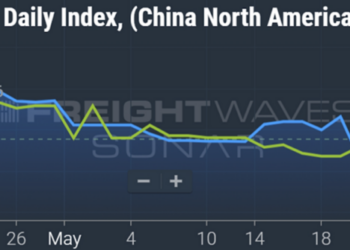With the sheer volume of logistics software tools on the market today, many shippers and carriers are finding it difficult to integrate and share data between incompatible platforms.
Thomas Kowalski, operations manager at CtrlChain, sat down with FreightWaves’ Timothy Dooner to discuss the inherent costs and problems that come with fragmented logistics platforms.
“The market is so fragmented right now that many companies use multiple tools on a day-to-day basis,” Kowalski said. “I can’t tell you how many times I’ve onboarded a new customer who is using three or four different systems just to achieve one load tender.”
To remain competitive, many companies are adding new software tools or platforms to their processes more quickly than they can adequately train their staff to optimize them. “It seems like every other day there’s a new tool that can help solve some issue,” said Kowalski. “But all that does in most cases is add to your product portfolio and your expenses.”
One major issue inherent in using multiple logistics tools is compatibility with a variety of carriers or partners. Even with a centralized platform, one company’s software may not be compatible with another’s. “Your TMS might not have a data-sharing agreement with your carrier’s visibility platform, for instance,” said Kowalski. “Then you ultimately have to answer questions: do I want to work with this carrier, do I want to make them move their visibility partner, or do I want to go back to emails and phone calls for tracking updates?”
These incompatibilities can have a cascading effect on relationships with other partners. “Most of the time, one partner will say, ‘This is the platform we’re using. Carrier, you have to figure that out,’” Kowalski explained. “It creates a lot of condensation in the system, and ultimately limits everyone’s options,” he added.
Having too many platforms inherently leads to higher operational costs, even when those platforms do integrate with a partner’s systems. Each tool comes with not only its own initial or recurring cost, but also time and resources lost to training internal staff and external parties. According to Kowalski, the more your company has to invest in training, the more likely it is to create costly inefficiencies. “When you have multiple platforms, individuals inevitably become more skilled at certain areas. That creates a bottleneck within your ecosystem and your supply chain,” he said.
Not only is this a cost to the organization, but it’s also an intangible drain on employees. “Being reliant on one person’s skills for a function creates terrible work-life balance. If you’re the only one who knows how to perform a certain function, you become vital and you’re going to get bugged on weekends and vacations because everyone else will need your help,” he said. That kind of pressure on experienced individuals stifles scalability, because eventually the workload becomes unmanageable.
Another consequence of trying to marry multiple incompatible systems, said Kowalski, is the increased likelihood of errors. “There’s cumbersome data entry when you have to go into each individual platform and make sure it’s updated properly. The more things that have to be done manually, the bigger chance there is for something to go wrong,” he said. “No one can be perfect every day.” As a result, he said, some customers have a bad experience due to bad data or delays at some point, and that can have hugely detrimental effects on satisfaction and retention.
CtrlChain’s goal is to solve these problems by standardizing and centralizing logistics platforms. “We consolidate your fragmented logistics processes and make them into a single, efficient platform that provides quality and consistency,” Kowalski said. “By eliminating all these issues we discussed, we cut a lot of costs and make your functions super user-friendly.”
According to Kowalski, onboarding new clients only takes about 30 minutes. “That helps new hires and anyone who has to fill in for a certain role to be able to use the system. A lot of platforms today require tribal knowledge that doesn’t transfer well, and we help you get away from those constraints,” he said.
CtrlChain automates everything from booking to invoicing, providing full visibility in each stage of the transportation process. “You can have all of this together in our portal and not have the headache of worrying about getting it wrong,” Kowalski said. “We can take so many of those tasks off your plate, and you can focus on other things.”
By simplifying and centralizing the various tools it takes to run a logistics company, Kowalski says, there are benefits beyond just cost savings. “We use automation to our advantage. We automate things to build relationships, not to replace them.”
Click here to learn more about CtrlChain.
The post Fragmentation of logistics tools leads to higher costs, system bottlenecks appeared first on FreightWaves.













